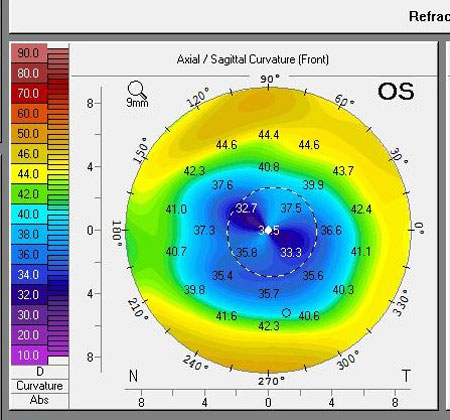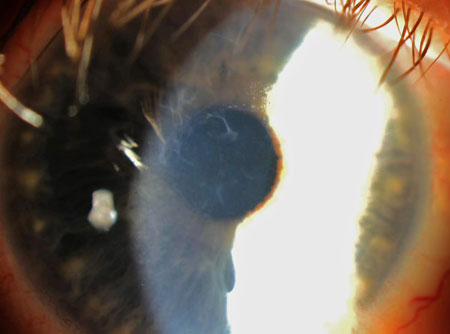BLOG: Corneal masqueraders of cataract-induced vision loss
Click Here to Manage Email Alerts
Cataract surgery is the most common surgery performed in the U.S. Because of the frequency we deal with these eyes, the process of referring a patient for surgery can become rote, with one patient feeling very much like the next.
It is, however, important to note that cataract surgery has the potential to influence other ocular problems, either for the better or for the worse. Likewise, comorbidities can influence the cataract outcomes, at a minimum by leading to patient dissatisfaction with the results and at a maximum by causing catastrophic complications.
Before recommending cataract surgery to your patient, it’s important that you’ve identified other, often less apparent, causes of reduced vision. These conditions also need to be discussed with your patient and may need to be treated or referred prior to making a referral for cataract surgery.
For our next several entries we’ll discuss noncataract sources of vision loss that may present along with the cataract evaluation and discuss other pathologies that may be exacerbated by the cataract surgery. Here we will look primarily at corneal masqueraders of cataract-induced vision loss.
Other vision-limiting pathology
Among the most important skills a doctor can have when it comes time to consider cataract surgery is to make sure the level of vision loss is consistent with the level of cataract. To effectively do this, the patient must be dilated, and the doctor must grade cataracts consistently (we’d recommend looking up the LOCS III cataract grading system, which is a classification system used to develop consistent cataract grading for research purposes).
Although there is interpatient variability in the extent that cataracts cause vision loss, you should have a “normal” range of expectations. Anything outside of that range should prompt more careful scrutiny of other ocular structures. Further, assessing the fellow eye and its vision can serve as a baseline. If two eyes have equivalent cataracts, their vision should be nearly equivalent; large discrepancies in this should tip you off to other pathology.
We’ve made a number of patients go through what turned out to be unnecessary visual field testing when cataracts don’t add up to the experienced vision loss and all other testing is normal. At the same time, however, we’ve also been involved with a number of cases that involved life-threatening pathology that started as cataract referrals, where the only clue to the larger problem was that the cataract did not add up to the level of vision loss.
Obviously, these are extreme examples, and not all noncataract sources of vision loss need to be treated prior to surgery, but they should always be identified and explained clearly to the patient prior to surgery so expectations for outcomes are appropriate.
Corneal irregularity limiting refractive outcomes
An opaque scarred cornea is an obvious source of vision loss so it won’t be mistaken for cataract-induced vision loss. The impact of abnormal corneal curvature on vision, however, can be extremely difficult to separate out from cataract-induced vision loss. In both cases, best spectacle corrected visual acuity will be reduced, and in both cases the cornea may appear clear and relatively normal.
However, keep in mind that corneal pathology doesn’t have to be clinically obvious on exam to create a significant reduction in vision that cataract surgery will not improve. We often see this in people with significant corneal flattening from radial keratotomy (RK). These patients will frequently complain of increased dimming of vision over time, which very easily masquerades as a symptom of worsening cataract but is in fact the impact of their increasingly oblate cornea on contrast sensitivity. Unfortunately, there is no good way to separate out this change from that induced by cataract, so plainly discussing with your patients whose visual symptoms are out of proportion with the level of their cataract that their symptoms may persist postcataract surgery is necessary to set expectations.

Another confounding corneal condition we occasionally see in patients presenting for cataract evaluation is epithelial basement membrane disease (EBMD). Many ODs are unaware that EBMD can cause irregular corneal astigmatism and subsequent vision loss, but we see this in clinic several times a year. Adding to the challenge these eyes present is the fact that, depending on the extent and location of the dystrophy, topographies may read as normal, even if the corneal irregularity exists, and can’t be fully trusted. If you have a patient with cataracts that are equivalent between the eyes, marked EBMD in one eye and reduced vision with best refraction in that eye, perform a diagnostic gas-permeable contact lens sphero-cylinder overrefraction. If the vision improves, this indicates the EBMD is causative for at least the difference between the manifest refraction and the GP-achieved vision, as the GP will correct for irregular astigmatism (caused by the dystrophy) but not the media opacity (caused by the cataract).
In these cases, debridement of the EBMD can precede any attempts at cataract surgery. This procedure can allow better long-term outcomes with subsequent cataract surgery and may allow an unnecessary cataract surgery to be avoided altogether. This tool works with differentiating all sources of corneal irregular astigmatism from cataract and can be applied to more than just EBMD.

Finally, any patient with astigmatism and irregular corneas should not be considered an ideal candidate for toric IOLs, as these eyes achieve less predictable outcomes with this technology. On occasion, and with a well-educated patient (where the stated goal is to reduce but not eliminate the glasses prescription), these lenses can be very helpful.
Dry eye
Dry eye is an exhaustively discussed, but sometimes underappreciated, source of reduced vision and, in severe cases, can alter surgical refractive outcomes by limiting the ability to measure keratometric data consistently as well as increasing risk of chronic postoperative irritation and photophobia. Unfortunately, both of these pathologies (cataract and dry eye) increase in incidence as we age, so it can be somewhat difficult to determine the true cause of a patient’s reduced vision.
When differentiating cataract-induced vision loss from that caused by dry eye, it’s important to question the patient about the quality of their vision loss. Is it generally stable throughout the day, with consistent worsening only in specific lighting conditions? That sounds like cataract. Is the vision loss variable, with periods of good vision followed by periods of poor vision, unrelated to changes in lighting, but perhaps related to visually demanding activities/environment? That sounds like ocular surface disease-induced vision loss (even if the patient has a diagnosable cataract). In a best-case scenario, preoperative treatment of dry eye may allow your patient to achieve satisfactory vision without needing cataract surgery. At a minimum, treatment of preoperative dry eye prior to referral can lead to more predictable refractive outcomes and enhanced patient comfort while they recover. It’s a win-win and should be taken care of prior to surgical referral.
With comanagement, consistency is key. If patients are hearing different things from multiple doctors about their vision, that can cause a loss of trust, dissatisfaction with care and confusion with outcomes. Corneal sources of reduced vision are frequently encountered and, even when subtle, need to be considered when the vision loss is not consistent with the level of cataract to make sure the right problem is being treated or, at minimum, to plant the seed with the patient that some vision loss may persist postoperatively.
